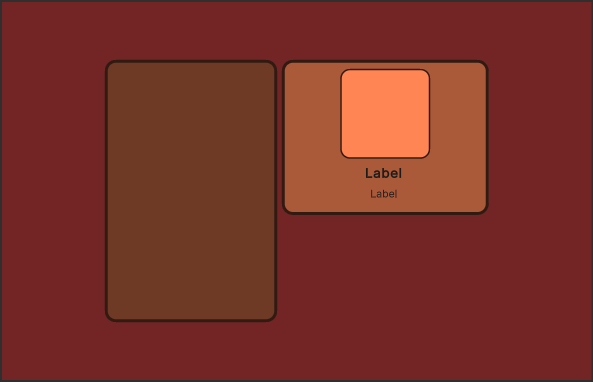运行时创建列表视图 UI
版本: 2022.3+
此示例演示如何运行时创建列表视图UI(用户界面) 允许用户与您的应用程序交互。Unity 目前支持三种 UI 系统。 更多信息
参见 术语表。此示例直接使用 UXML 和 USS 文件来创建 UI 的结构和样式。如果您不熟悉 UI 工具包并希望使用 UI Builder 创建 UI,请参阅 使用 UI Builder 创建示例 UI。
示例概述
此示例创建了一个简单的角色选择屏幕。当您从左侧列表中点击角色名称时,角色的详细信息将显示在右侧。

您可以在此 GitHub 存储库 中找到此示例创建的完整文件。
先决条件
本指南适用于熟悉 Unity 编辑器、UI 工具包和 C# 脚本的开发人员。在开始之前,请熟悉以下内容
创建主 UI 文档
创建主视图 UI 文档和一个 USS 文件来设置视觉元素视觉树的一个节点,它实例化或派生自 C# VisualElement 类。您可以设置外观样式、定义行为并在屏幕上将其显示为 UI 的一部分。 更多信息
参见 术语表的样式。在 UI 文档中添加两个视觉元素作为容器:一个包含角色名称列表,另一个包含所选角色的详细信息。

在 Unity 中使用任何模板创建一个项目。
在项目窗口显示
Assets文件夹内容的窗口(项目选项卡) 更多信息
参见 术语表中,创建一个名为UI的文件夹来存储所有 UI 文档和样式表文件。-
在
UI文件夹中,创建一个名为MainView.uxml的 UI 文档,其内容如下<ui:UXML xmlns:ui="UnityEngine.UIElements" xmlns:uie="UnityEditor.UIElements" editor-extension-mode="False"> <Style src="MainView.uss" /> <ui:VisualElement name="background"> <ui:VisualElement name="main-container"> <ui:ListView focusable="true" name="character-list" /> <ui:VisualElement name="right-container"> <ui:VisualElement name="details-container"> <ui:VisualElement name="details"> <ui:VisualElement name="character-portrait" /> </ui:VisualElement> <ui:Label text="Label" name="character-name" /> <ui:Label text="Label" display-tooltip-when-elided="true" name="character-class" /> </ui:VisualElement> </ui:VisualElement> </ui:VisualElement> </ui:VisualElement> </ui:UXML> 在
UI文件夹中,创建一个名为MainView.uss的 USS 样式表,其内容如下
#background {
flex-grow: 1;
align-items: center;
justify-content: center;
background-color: rgb(115, 37, 38);
}
#main-container {
flex-direction: row;
height: 350px;
}
#character-list {
width: 230px;
border-color: rgb(49, 26, 17);
border-width: 4px;
background-color: rgb(110, 57, 37);
border-radius: 15px;
margin-right: 6px;
}
#character-name {
-unity-font-style: bold;
font-size: 18px;
}
#character-class {
margin-top: 2px;
margin-bottom: 8px;
padding-top: 0;
padding-bottom: 0;
}
#right-container {
justify-content: space-between;
align-items: flex-end;
}
#details-container {
align-items: center;
background-color: rgb(170, 89, 57);
border-width: 4px;
border-color: rgb(49, 26, 17);
border-radius: 15px;
width: 252px;
justify-content: center;
padding: 8px;
height: 163px;
}
#details {
border-color: rgb(49, 26, 17);
border-width: 2px;
height: 120px;
width: 120px;
border-radius: 13px;
padding: 4px;
background-color: rgb(255, 133, 84);
}
#character-portrait {
flex-grow: 1;
-unity-background-scale-mode: scale-to-fit;
}
.unity-collection-view__item {
justify-content: center;
}
创建列表条目 UI 文档
为列表中的各个条目创建 UI 文档和样式表。角色列表条目包括一个彩色背景框架和角色的名称。

-
在
UI文件夹中,创建一个名为ListEntry.uxml的 UI 文档,其内容如下<ui:UXML xmlns:ui="UnityEngine.UIElements" xmlns:uie="UnityEditor.UIElements" editor-extension-mode="False"> <Style src="ListEntry.uss" /> <ui:VisualElement name="list-entry"> <ui:Label text="Label" display-tooltip-when-elided="true" name="character-name" /> </ui:VisualElement> </ui:UXML> 在
UI文件夹中,创建一个名为ListEntry.uss的样式表文件,其内容如下
#list-entry {
height: 41px;
align-items: flex-start;
justify-content: center;
padding-left: 10px;
background-color: rgb(170, 89, 57);
border-color: rgb(49, 26, 17);
border-width: 2px;
border-radius: 15px;
}
#character-name {
-unity-font-style: bold;
font-size: 18px;
color: rgb(49, 26, 17);
}
创建要显示的示例数据
创建示例数据以填充 UI 中的角色列表。对于角色列表,创建一个类来保存角色名称、类别和肖像图像。
在 Asset 文件夹中,创建一个名为
Scripts的文件夹来存储您的 C#脚本一段代码,允许您创建自己的组件、触发游戏事件、随时间推移修改组件属性并以任何您喜欢的方式响应用户输入。 更多信息
参见 术语表。-
在
Scripts文件夹中,创建一个名为CharacterData.cs的 C# 脚本,其内容如下using UnityEngine; public enum ECharacterClass { Knight, Ranger, Wizard } [CreateAssetMenu] public class CharacterData : ScriptableObject { public string CharacterName; public ECharacterClass Class; public Sprite PortraitImage; }这将在 Assets > Create 菜单中创建 角色数据项。
在 Assets 文件夹中,创建一个名为
Resources的文件夹。在
Resources文件夹中,创建一个名为Characters的文件夹来存储所有示例角色数据。在
Characters文件夹中,右键单击并选择 Create > Character Data 以创建ScriptableObject的实例。创建更多
CharacterData实例并使用占位符数据填充它们。
设置场景
在 SampleScene 中创建一个 UIDocument游戏对象Unity 场景中的基本对象,可以表示角色、道具、场景、摄像机、路径点等等。游戏对象的功能由附加到它的组件定义。 更多信息
参见 术语表,并将 UI 文档作为源资产添加。
- 在 SampleScene 中,选择 GameObject > UI Toolkit > UI Document。
- 在 Hierarchy 窗口中选择 UIDocument 游戏对象。
- 将 MainView.uxml 从项目窗口拖动到 检查器一个 Unity 窗口,显示有关当前选定游戏对象、资产或项目设置的信息,允许您检查和编辑值。 更多信息
参见 术语表窗口中 UI Document 组件的 Source Asset 字段。这将源资产引用到 UXML 文件。
为列表条目和主视图创建控制器
创建两个具有以下类的 C# 脚本
- 一个
CharacterListEntryController类,用于在列表条目的 UI 中显示角色实例的数据。它需要访问角色名称的标签并将其设置为显示给定角色实例的名称。 - 一个
CharacterListController类,用于主视图中的角色列表,以及一个MonoBehaviour脚本,它实例化并将其分配给视觉树一个对象图,由轻量级节点组成,它保存窗口或面板中的所有元素。它定义了您使用 UI 工具包构建的每个 UI。
参见 术语表。
注意:CharacterListEntryController 类不是 MonoBehaviour。由于 UI 工具包中的视觉元素不是游戏对象,因此您无法将组件附加到它们。相反,您将类附加到 CharacterListController 类中的 userData 属性。
-
在
Scripts文件夹中,创建一个名为CharacterListEntryController.cs的 C# 脚本,其内容如下using UnityEngine.UIElements; public class CharacterListEntryController { Label m_NameLabel; // This function retrieves a reference to the // character name label inside the UI element. public void SetVisualElement(VisualElement visualElement) { m_NameLabel = visualElement.Q<Label>("character-name"); } // This function receives the character whose name this list // element is supposed to display. Since the elements list // in a `ListView` are pooled and reused, it's necessary to // have a `Set` function to change which character's data to display. public void SetCharacterData(CharacterData characterData) { m_NameLabel.text = characterData.CharacterName; } } -
在
Scripts文件夹中,创建一个名为CharacterListController.cs的 C# 脚本,其内容如下using System.Collections.Generic; using UnityEngine; using UnityEngine.UIElements; public class CharacterListController { // UXML template for list entries VisualTreeAsset m_ListEntryTemplate; // UI element references ListView m_CharacterList; Label m_CharClassLabel; Label m_CharNameLabel; VisualElement m_CharPortrait; List<CharacterData> m_AllCharacters; public void InitializeCharacterList(VisualElement root, VisualTreeAsset listElementTemplate) { EnumerateAllCharacters(); // Store a reference to the template for the list entries m_ListEntryTemplate = listElementTemplate; // Store a reference to the character list element m_CharacterList = root.Q<ListView>("character-list"); // Store references to the selected character info elements m_CharClassLabel = root.Q<Label>("character-class"); m_CharNameLabel = root.Q<Label>("character-name"); m_CharPortrait = root.Q<VisualElement>("character-portrait"); FillCharacterList(); // Register to get a callback when an item is selected m_CharacterList.selectionChanged += OnCharacterSelected; } void EnumerateAllCharacters() { m_AllCharacters = new List<CharacterData>(); m_AllCharacters.AddRange(Resources.LoadAll<CharacterData>("Characters")); } void FillCharacterList() { // Set up a make item function for a list entry m_CharacterList.makeItem = () => { // Instantiate the UXML template for the entry var newListEntry = m_ListEntryTemplate.Instantiate(); // Instantiate a controller for the data var newListEntryLogic = new CharacterListEntryController(); // Assign the controller script to the visual element newListEntry.userData = newListEntryLogic; // Initialize the controller script newListEntryLogic.SetVisualElement(newListEntry); // Return the root of the instantiated visual tree return newListEntry; }; // Set up bind function for a specific list entry m_CharacterList.bindItem = (item, index) => { (item.userData as CharacterListEntryController)?.SetCharacterData(m_AllCharacters[index]); }; // Set a fixed item height matching the height of the item provided in makeItem. // For dynamic height, see the virtualizationMethod property. m_CharacterList.fixedItemHeight = 45; // Set the actual item's source list/array m_CharacterList.itemsSource = m_AllCharacters; } void OnCharacterSelected(IEnumerable<object> selectedItems) { // Get the currently selected item directly from the ListView var selectedCharacter = m_CharacterList.selectedItem as CharacterData; // Handle none-selection (Escape to deselect everything) if (selectedCharacter == null) { // Clear m_CharClassLabel.text = ""; m_CharNameLabel.text = ""; m_CharPortrait.style.backgroundImage = null; return; } // Fill in character details m_CharClassLabel.text = selectedCharacter.Class.ToString(); m_CharNameLabel.text = selectedCharacter.CharacterName; m_CharPortrait.style.backgroundImage = new StyleBackground(selectedCharacter.PortraitImage); } }
将控制器脚本附加到主视图
CharacterListController 不是 MonoBehaviour,因此您无法将其直接附加到游戏对象。为了克服这个问题,创建一个 MonoBehaviour 脚本并将其附加到与 UIDocument 相同的游戏对象。在此脚本中,您不需要实例化 MainView.uxml,因为它已由 UIDocument 组件实例化。相反,访问 UIDocument 组件以获取已实例化视觉树的引用。然后,创建 CharacterListController 的实例并传入视觉树的根元素以及用于单个列表元素的 UXML 模板。
注意:当 UI 重新加载时,包含 UIDocument 组件的相同游戏对象上的任何关联的 MonoBehaviour 组件在重新加载之前会被禁用,然后在重新加载后重新启用。因此,您必须将与 UI 相关的代码放在此 MonoBehaviour 的 OnEnable 和 OnDisable 方法中。有关更多信息,请参阅 在游戏视图中渲染 UI。
-
在
Scripts文件夹中,创建一个名为MainView.cs的 C# 脚本,其内容如下using UnityEngine; using UnityEngine.UIElements; public class MainView : MonoBehaviour { [SerializeField] VisualTreeAsset m_ListEntryTemplate; void OnEnable() { // The UXML is already instantiated by the UIDocument component var uiDocument = GetComponent<UIDocument>(); // Initialize the character list controller var characterListController = new CharacterListController(); characterListController.InitializeCharacterList(uiDocument.rootVisualElement, m_ListEntryTemplate); } } 在 SampleScene 中,选择 UIDocument。
将
MainView.cs拖到检查器窗口中的 添加组件。将 ListEntry.uxml 拖到 ListEntry Template 字段。
进入播放模式以查看在游戏视图中显示的 UI。